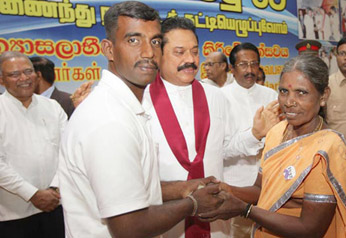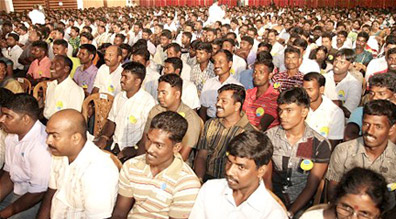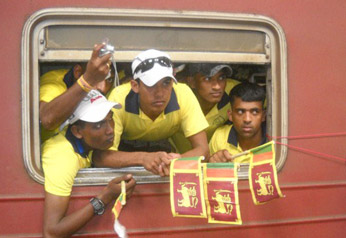Northern youth rehabilitation program, a huge success
By Ranil Wijayapala
The end of nearly three-decades-long war in Sri Lanka with the
completion of the humanitarian operation on May 19, 2009 opened a number
of challenges to Sri Lanka. The development of the war-torn areas,
resettlement of the displaced civilians, bringing back the law and order
situation in the North East were among the big challenges the Government
had to face after the completion of the humanitarian operation which
completely defeated the LTTE terrorism in May 2009.

President Mahinda Rajapaksa at the 'reuniting ceremony' of
rehabilitated LTTE cadres to their families |
 |
| Rehabilitated
cadres who have been released |
 |
| Youth exchange
program |
However, along with that challenging tasks the Government also had to
take up another massive task of rehabilitating nearly 12,000 combatants
who were either surrendered or arrested at the final phases of the
humanitarian operation and also detected when screening the civilians
who were lodged at welfare centres until they were resettled in their
villages.
Today, almost four years after ending the humanitarian operation, the
Government is facing all those challenges effectively by successfully
accomplishing the development, resettlement and also rehabilitation
processes parallel to each process while establishing law and order
situation in the North to ensure sustainable peace. To get a clear view
about the process of rehabilitation of ex-combatants and their
reintegration into the society, one of the arduous tasks before the
Government, the Sunday Observer interviewed Major General K.J.
Wijetilleke presently the Commissioner General of Rehabilitation.
Following are excerpts of the interview:
Question: At the end of the humanitarian operation we got
information that nearly 12,000 ex-combatants were detained with the law
enforcement authorities and they were directed towards rehabilitation.
Can you explain the present position of the rehabilitation and
reintegration of ex-combatants?
Answer: We got close to 12,000 ex-combatants who had
voluntarily come in and surrendered to the Security Forces. During the
past four years we have been able to rehabilitate them and I think 99
percent of them have already been rehabilitated and reintegrated to the
society. As of today I have about 344 including 15 females. They are in
the process of rehabilitating and a batch of 134 will be released in the
month of September. With that, I feel almost all the ex-combatants have
been rehabilitated unless there are cadres sent to us for rehabilitation
by the Courts. That is a very minimal number. Even present 344
ex-combatant who are with us were sent sent to us by Courts. So we have
only that much left with us. Whoever the cadres isolated cadres will be
sent to use from the Courts to rehabilitation.
Q:How do you evaluate the progress of the reinsertion and
reintegration of those ex-combatants?
A: During the process of rehabilitation we did counseling for
those ex-combatants. It was a very systematic approach and process.
Because we identified their strengths and their weaknesses. In the
previous batch there were 594 child combatants. They have 100 percent
reintegrated and very few are minors were among them at the time of
completing their rehabilitation and other are over 18. They have been
reintegrated into the society. Some of them have chosen higher studies,
some have entered universities and some are involved in employment. Even
otherwise the elders are also the same.
When reintegrating them to the society we very strictly follow the
family unit concept. We ensure that after rehabilitation they are
joining their kith and kin so that they are being resettled in their
original habitats. At the same time we ensure that they get the
livelihood assistance and also during the process of rehabilitation and
even after the rehabilitation the Government is supporting them
financially.
Q: What are the mechanisms put in place to assist these
ex-combatants reintegrated to the society to restart their lives?
A: We are providing them soft loans for them to start self
employment. So far I think over 50 percent loans have been released to
these rehabilitated cadres. There are about 4,572 applications being
processed to provide loans. The Government has allocated over Rs.500
million to release loans for the rehabilitated ex-combatants and that
will be releases to them this year. There is a delay in releasing those
loans as there is a procedure to be followed when releasing those loans.
The Government Agent has to scrutinise them and there is a procedure
that is being followed by the GA also. It is being done at the moment
and then they will be sent to the Rehabilitation Authority under the
Prisons Reforms and Rehabilitation. That authority will release the
payment through a Bank. That is the process they follow. It is a very
low interest loan and the loan interest is only four percent.
Q: What are the requirements they have to fulfill to obtain
those loans?
A: We get them to identify a project to start their livelihood
based on the skills they have obtained vocational training they
underwent during the rehabilitation. We have sort of molded them to take
up some employment. Then they goes into the society with some knowledge
and skills. All these courses leads to a National Vocational
Qualification certificate. Even for women there are certain courses such
as beautician programs. The loan that the Government gives them is based
on the project proposal they give which they intend to start once they
are reintegrated. The money will be given to them to start that project.
So it is a project of their own choice which they have decided to earn
and income for their living.
Q: Another problem faced by these ex-combatants is the
livelihood for their families whilst they are undergoing rehabilitation.
How did you address this situation?
A: What we were trying to put across was to support their
families and children whilst they are in the rehabilitation centers.
That will ensure that they are not isolated and they are being looked
after. They are being looked after by the Government agencies, they are
being supported by the NGOs and INGOs. So their families are looked
after well and these ex-combatants feel that their families are not
neglected. That is the main purpose. We also ensure that their children
go to better schools and get better education.
Q: How do you asses the progress of the ex-combatants who have
already reintegrated to the society and how they are progressing with
their lives?
A: If you really look at the employment rate I should say
every person who have been rehabilitated and reintegrated actually earn
a living. Either they are self employed, farmers or fishermen. Many of
them are also working in the development sector infrastructure
development projects, as labourers, machine operators, carpenters and
all these trades as they have been provided with vocational training
during their rehabilitation. We put them as very responsible citizen to
the society so that there won't be a relapse in the future of the same
kind in any of these areas. Therefore, only 12 percent of the
reintegrated ex-combatants are unemployed at present and they are also
working as labourers.
Q: Is there any mechanism to monitor their activities after
they were reintegrated to the society?
A: We don't monitor them but we have a program called a follow
up system. That is simply to ensure their socio economic standards are
maintained in the society. Otherwise our one year effort is useless.
This mechanism is totally a civilian set up and under the Government
Agent. A unit has been established with the GAs. They go to these people
and assess the improvements they have made in their jobs and in their
life style. If they see a gap they will address that. They support them
if somebody needs a loan. That is totally to ensure that these people
make a progress in their lives. Otherwise there will be stagnation which
we don't want to happen to see at the end.
Q: What are social issues they are facing once they are
reintegrated?
A: If you really saw the situation in 2009 and the challenges
we faced after the war in those areas and today if you can go and see to
what extent those challenges have been addressed, you will find the
answer to that. Why I say is that in 2009 we had nearly 300,000 IDPs and
the Government had to spend one million US dollars a day to maintain
Menik Farm welfare centres.
The areas were heavily mined and there was no economic development
and the economy was stagnating there and had negative growth at that
time in those areas. The fisheries which contributed 30 percent of the
national production from Mullaitivu and Trincomalee areas and that was
disrupted. The entire education system was disrupted. Now normalcy has
returned and the dividends of peace is there now. Every sector is
performing well there.
The resettled people are living in Kilinochchi and Mullaitivu
districts and that is the main base of those ex-combatants. Out of
around 12,000 ex-combatants 2,883 are from Kilinochchi, 2,382 are from
Mullaitivu and 3,145 are from Jaffna. These people have gone back to
their villages. If you really take their disposition except for one or
two isolated cases all of them are staying in their original habitats
and they are also much comfortable with the Security Forces there.
Police is there now. The challenges they faced in 2009 are no longer
there now. Now the law and order is maintained and they can go to a
police station and lodge a complaint regarding any issue. Judicial
system is also re-established there and they have freedom of speech,
freedom of movement and they have communication network now. Every
sector has done its best and in that sense I think the social issues
they are facing are now at minimal level as they are living in normal
conditions unlike in the past.
Q: Have you ever got any complaint about any of these
rehabilitated and reintegrated cadres engaged in criminal or violent
activities?
A: Let me answer your question this way. Today basically in
the areas where the final battle was going on, these ex-combatants are
the people who gave us information on locations where the arms are
hidden which cannot be used. On a daily basis we recovered mines, we
recovered ammunition and weapons. They are the people who gave us the
information. Now this bureau can be satisfied that their rehabilitation
process had been effective to change these people mindset.
Q: There are reports to indicate that there is a refusal from
the Tamil community to accept these rehabilitated ex-combatants back in
the society. How do you tackle this situation?
A: That is another task of the follow up teams to update and
educate senior citizen and community, the educated people irrespective
of their cast creed about this situation that every ex-combatant has now
come back to the society. Otherwise these ex-combatants will not be
accepted within the community. So that is a great challenge that we face
and so far things are flowing smoothly. For example, if I were a normal
civilian and if you were an ex-combatant you have come and taken my
brother or sister forcibly and my brother is dead, when you are coming
back to the society there will be a dissent in my mind against you. I
will be reluctant to accept you. When I see you I have an anger. That is
human nature. But this is what we are addressing now.
That is what the religious leaders, even in their Sunday masses or at
the religious ceremonies at the Kovil, are educating the people now.
Those are the steps that are being taken to ensure that they live in
harmony as one community.
Q: Whatever said and done these ex-combatants were from a
terrorist organisation they also had some sort of political ideology. Do
you see any trend among these rehabilitated cadres to enter into the
mainstream politics?
A: If you take the East even now in most of the village there
is a thing called Rural Development Society within the GN Division.
Those are been headled by those ex-combatants and they have been
accepted by the community. It will take a little time to heal this wound
but they are being gradually accepted by the community. Our focus is
also that they will reconcile well and they won't have any hatred. But
you can't expect hundred percent patching up overnight. If we expect
like that we are being too optimistic.
Q: How do you assess the overall progress of the reintegration
process of the ex-combatants?
A: I won't show you a hundred percent rosy picture. But I can
say that so far things are on the better side. There may be one or two
isolated incidents. Even if you take in the South still there are
communities clashing. But you don't get that in the North. Yes, there
was a refusal when they came to the area immediately after the
rehabilitation. The community was saying why are we supporting the
ex-combatants. They are the people who fought with them. During the
thirty years of war these people were in the jungle. Naturally they did
not see the society and they did not see the people. They saw only
animals and they heard only gunfire. So I think this much of success
that we achieve could be seen anywhere in the world. That is the success
story. If somebody is trying to say that there is no progress these
facts are more than enough to prove whether it is a success story or
not.
Q: What kind of feedback are you getting from the
International organisations which may be monitoring the process of
rehabilitation?
A: They have always talked positively about the development
that has taken place from what I interact so far. Before I was appointed
here I was in Mullaitivu. We had a team of Tamil diaspora visiting that
district and when they came we just let them go to the field first and
allowed them to observe what was happening there. Then only we had
interaction with them. They came and told us that they don't know why
the people in the world are pointing their finger at Sri Lanka as what
they heard was not what was happening in the ground. They said they got
a different picture. They said they didn't get the exact picture of this
development before coming here and they could not believe because even
the rehabilitated cadres were allowed to go to their families and come
whenever possible. We allow their families to come and visit them when
they are undergoing rehabilitation. So what they say is they never
expect such development. However, the utterances of the international
community may be due to their hidden agenda. If you say good about
everything there is no news. So people need to come and see for
themselves and judge for themselves what is exactly happening.
Q: What more to be done in this process?
A: We should understand that this country was in war for 30
years. Our economy was disturbed, the industrial sector was disturbed so
we have to start from scratch. You can't expect more than this within
four years period. This is much more than what you could see in about
two decades but it has happened during the past four years. So we are
far ahead of what we should be achieved and our end goals. I think the
progress we have made so far is a very very outstanding progress when
you look at the country as citizen. Those rehabilitated and reintegrated
ex-combatants and even the Tamil community get electricity connection
free of charge. You see the difference. That is the interest the
leadership has shown towards those people, because these areas were
disturbed due to war and these people were provided with all these
facilities. Now they are getting things that have to be addressed even
in the South. Therefore, we will be much progress in the near future. |


